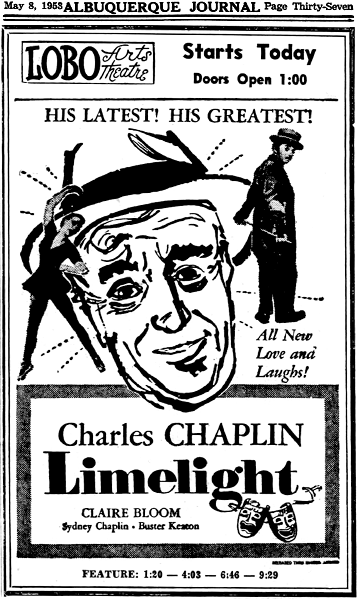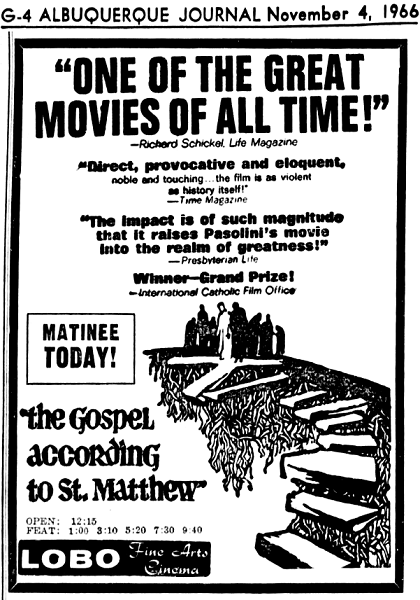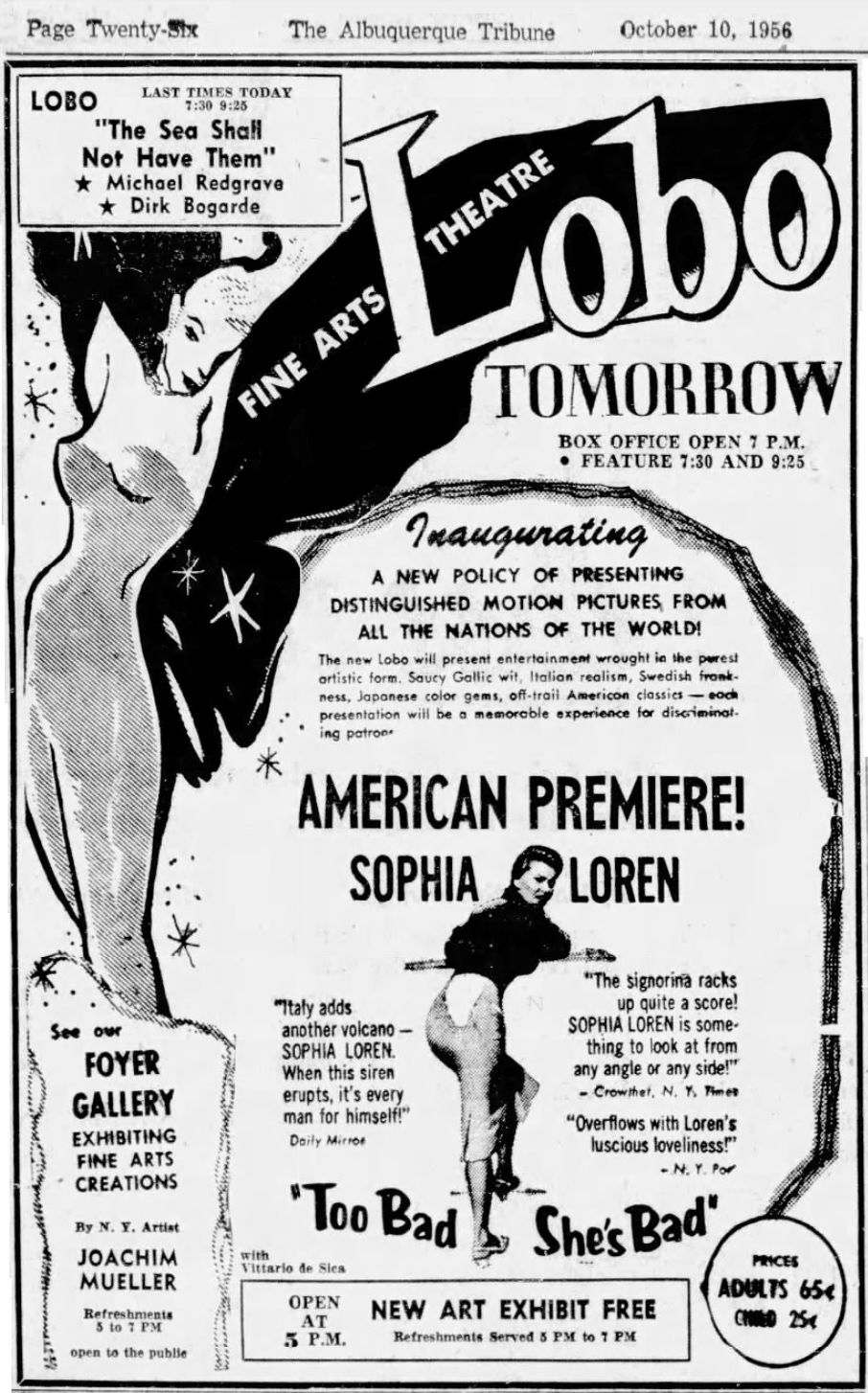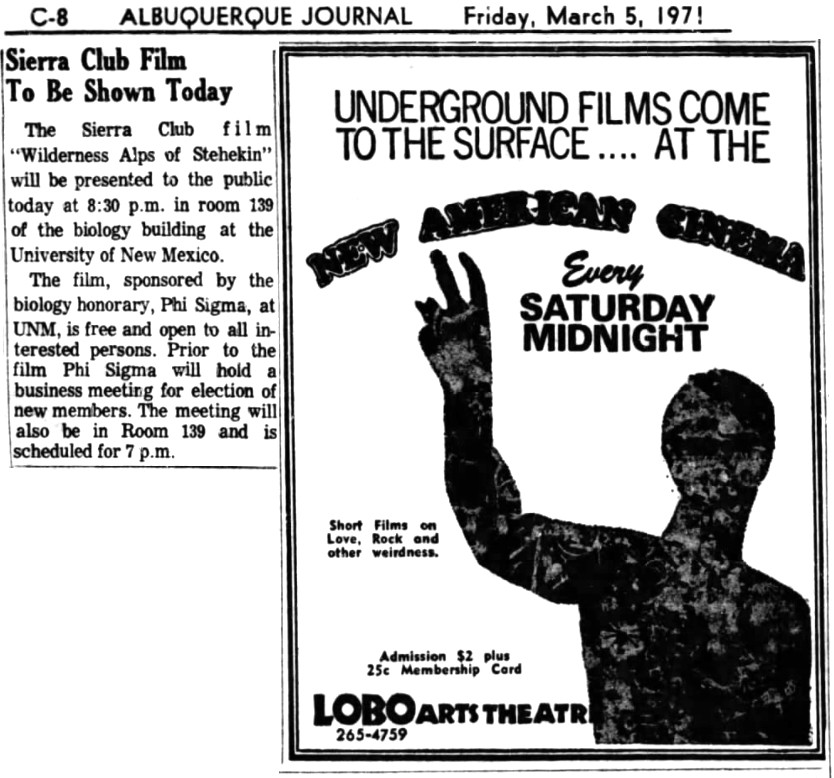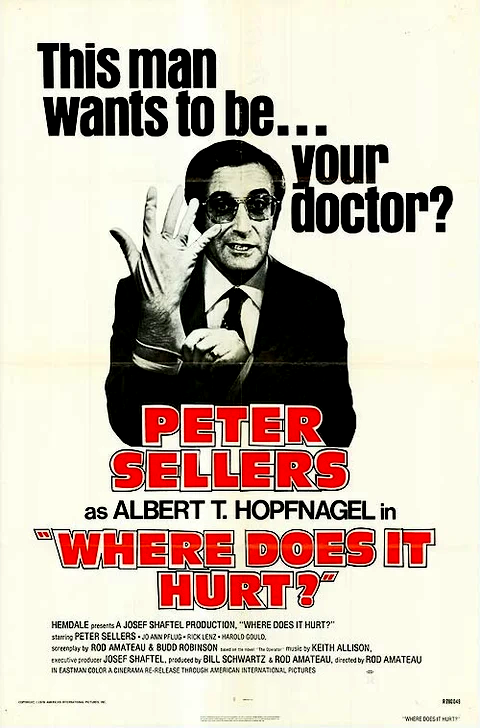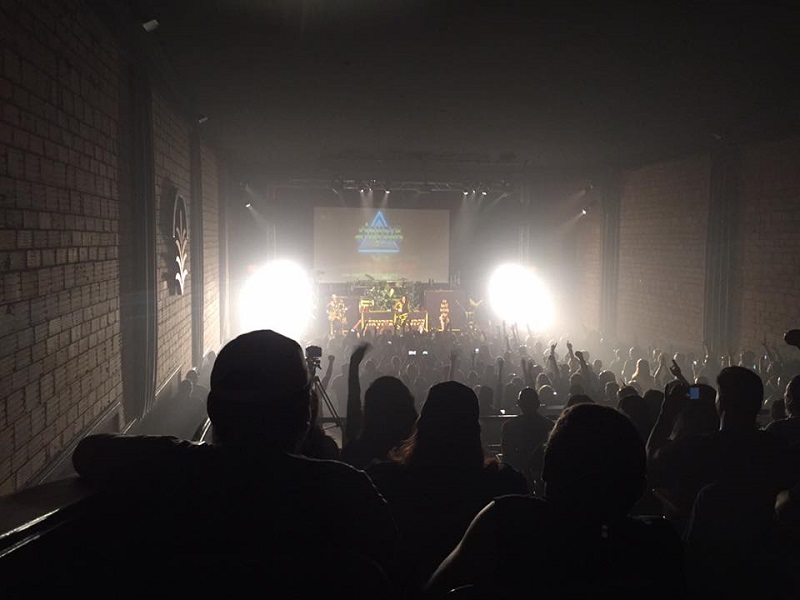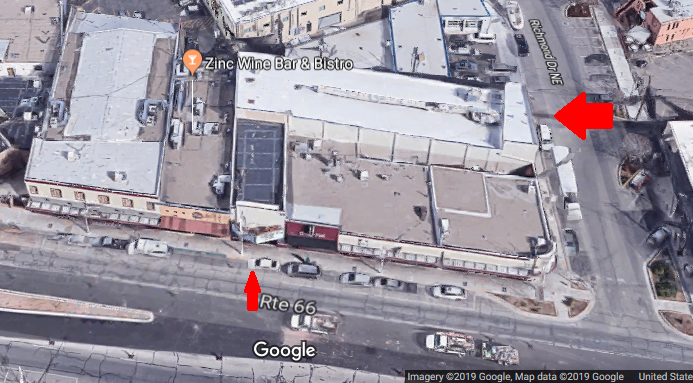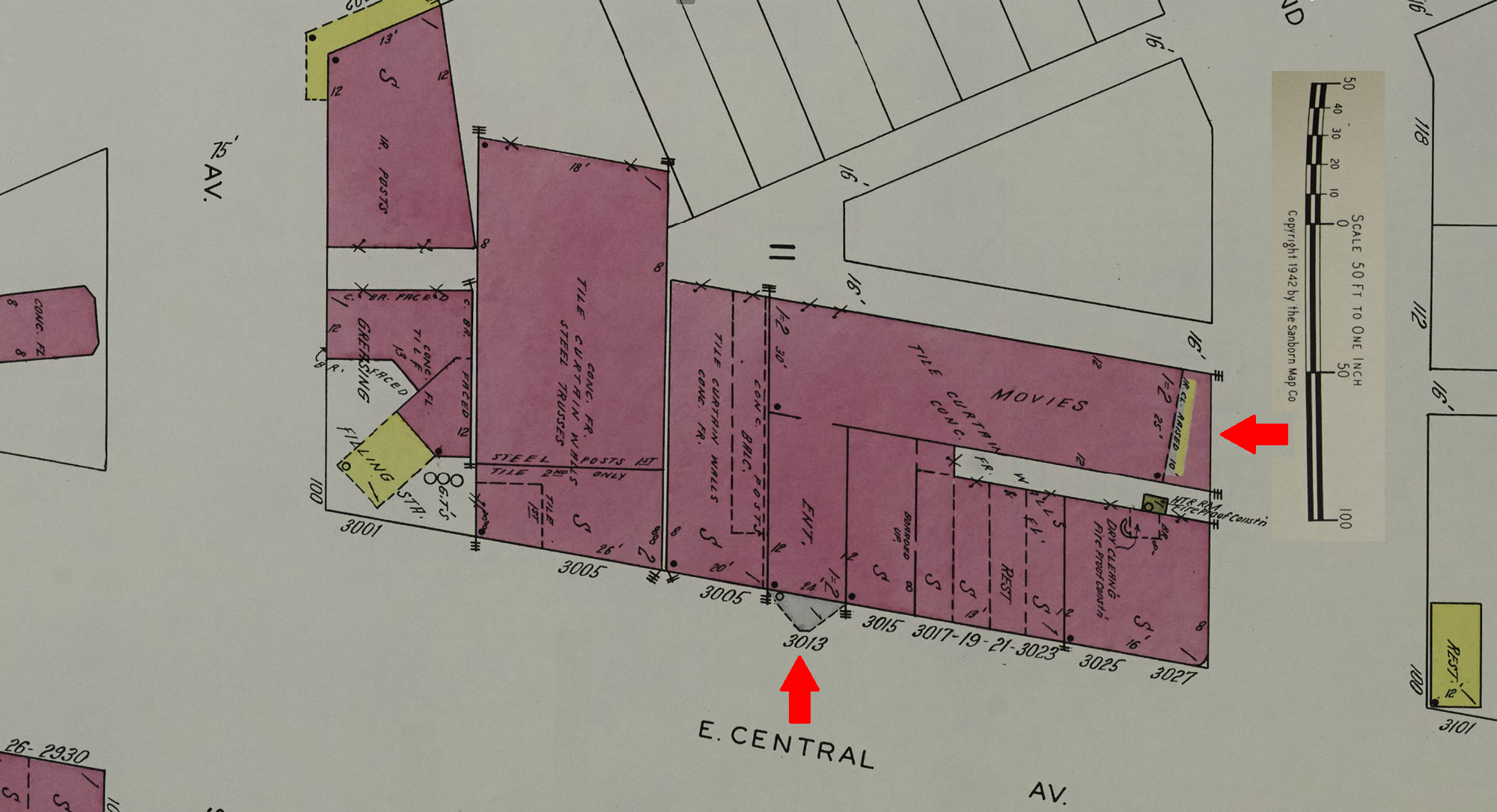Chapter 4
The Lobo Fine Arts Cinema
The Lobo Fine Arts Cinema
When Hollywood movies played, the ads gave the name of the cinema as “Lobo.”
Once better movies began to predominate, the ads often gave the name of the cinema as
the “Lobo Arts Theatre,” or the “Lobo Fine Arts Cinema.”
It had some good programming and maybe, maybe, maybe the projectionists were showing the films properly in those days.
Would I ever find the time and patience to document all the Lobo’s bookings?
Probably, before century’s end.
In the meantime, I can confirm that, during the years when the Lobo was just an ordinary neighborhood cinema,
devoted primarily to second and third run,
a few exceptional movies did pop up, not by design, at first, but just by chance.
Those were the movies that were available, and so they were shipped to the Lobo.
There was no intention by the bookers or by the managers or owners to set out to get a particular type of product.
They just got whatever the giant wheel happened to dump upon them that particular day.
That’s all.
But that was not all for long.
Audiences turned out for those oddballs, and so Albuquerque Exhibitors got the idea that this was a formula that was working.
Hesitantly, they began to bring in more and more.
Amidst the standard flood of Lassie and Bonzo and Ma and Pa Kettle, a few interesting items were delivered to the Lobo’s doorstep:
| Fri 05 May 1950 | Tight Little Island | 4 days | Lobo |
| Thu 25 May 1950 | Spring in Park Lane (1st run) | 2 days | Lobo |
| Thu 06 Jul 1950 | The Bicycle Thief (1st run) | 5 days | Lobo |
| Thu 13 Jul 1950 | The Winslow Boy (1st run) | 2 days | Lobo |
| Wed 22 Sep 1950 | The Rocking Horse Winner | 2 days | Lobo |
| Fri 29 Sep 1950 | Passport to Pimlico (1st run) | 2 days | Lobo |
| Sun 01 Oct 1950 | The Astonished Heart (1st run) | 3 days | Lobo |
| Fri 03 Nov 1950 | City Lights | 5 days | Lobo |
| Sun 12 Nov 1950 | Kind Hearts and Coronets (1st run) | 4 days | Lobo |
| Thu 16 Nov 1950 | Madness of the Heart (1st run) | 2 days | Lobo |
| Sat 18 Nov 1950 | Hamlet | 4 days | Lobo |
| Fri 24 Nov 1950 | Henry V | 5 days | Lobo |
| Wed 28 Nov 1950 | A Run for Your Money (1st run) | 2 days | Lobo |
| Wed 06 Dec 1950 | The Barber of Seville | 3 days | Lobo |
| Sun 11 Feb 1951 | Macbeth | 3 days | Lobo |
| Wed 28 Feb 1951 | Don Quixote (subtitles) | 2 days | Lobo |
| Wed 04 Apr 1951 | The Blue Angel (subtitles) | 2 days | Lobo |
| Sun 29 Apr 1951 | Bitter Rice | 3 days | Lobo |
| Mon 14 Apr 1952 | The Red Shoes | 3 days | Lobo |
| Fri 25 Apr 1952 | Rasho-Mon | 6 days | Lobo |
| Thu 05 Jun 1952 | The Lavender Hill Mob | 7 days | Lobo |
| Thu 19 Jun 1952 | The River | 7 days | Lobo |
| Thu 26 Jun 1952 | Tales of Hoffmann | 7 days | Lobo |
| Thu 03 Jul 1952 | The Browning Version | 7 days | Lobo |
| Thu 10 Jul 1952 | Encore | 7 days | Lobo |
| Thu 17 Jul 1952 | Caesar and Cleopatra | 7 days | Lobo |
| Thu 24 Jul 1952 | Navajo | 7 days | Lobo |
| Thu 31 Jul 1952 | Song of My Heart | 7 days | Lobo |
| Thu 07 Aug 1952 | Outcast of the Islands | 7 days | Lobo |
| Thu 14 Aug 1952 | Trio | 3 days | Lobo |
| Sun 17 Aug 1952 | Quartet | 4 days | Lobo |
| Thu 21 Aug 1952 | The Adventuress | 3 days | Lobo |
| Sun 24 Aug 1952 | Queen of Spades | 4 days | Lobo |
| Thu 28 Aug 1952 | Kind Hearts and Coronets | 3 days | Lobo |
| Sun 31 Aug 1952 | Odette | 4 days | Lobo |
| Thu 04 Sep 1952 | Her Wonderful Life (Addio Mimí!, 1947) | 7 days | Lobo |
| Thu 11 Sep 1952 | The Dancing Years | 6 days | Lobo |
| Wed 17 Sep 1952 | Last Holiday | 4 days | Lobo |
| Sun 21 Sep 1952 | Faust and the Devil | 4 days | Lobo |
| Thu 25 Sep 1952 | The Wild Heart | 7 days | Lobo |
| Thu 02 Oct 1952 | Lady Possessed | 6 days | Lobo |
| Wed 08 Oct 1952 | Faithful City | 4 days | Lobo |
| Sun 12 Oct 1952 | Pardon My French | 3 days | Lobo |
| Wed 15 Oct 1952 | The Well | 7 days | Lobo |
| Wed 22 Oct 1952 | The Lady Vanishes | 4 days | Lobo |
| Sun 26 Oct 1952 |
BACK TO NORMAL PROGRAMMING, CONTINUOUS PERFORMANCES | 85 days | Lobo |
| Mon 19 Jan 1953 | Pagliacci | 4 days | Lobo Arts Theatre |
| Mon 26 Jan 1953 | The Girl in the Painting | 4 days | Lobo Arts Theatre |
| Mon 02 Feb 1953 | Her Panelled Door | 4 days | Lobo Arts Theatre |
| Fri 06 Feb 1953 | The Man in the White Suit | 7 days | Lobo Arts Theatre |
| Mon 16 Feb 1953 | Mad about Opera | 2 days | Lobo Arts Theatre |
| Mon 23 Feb 1953 | Pool of London | 4 days | Lobo Arts Theatre |
| Mon 02 Mar 1953 | You Can’t Beat the Irish ON STAGE: George Fenley, violin |
4 days | Lobo Arts Theatre |
| Mon 09 Mar 1953 | Cry, the Beloved Country ON STAGE: Wilma Tapp, piano |
4 days | Lobo Arts Theatre |
| Mon 16 Mar 1953 | Carnegie Hall ON STAGE: John Large, baritone |
4 days | Lobo Arts Theatre |
| Fri 20 Mar 1953 | The Four Poster ON STAGE: Vera Rozdestvensky, piano |
7 days | Lobo Arts Theatre |
| Mon 30 Mar 1953 | The Member of the Wedding ON STAGE: Marilyn Langmyer, soprano |
4 days | Lobo Arts Theatre |
| Mon 06 Apr 1953 | Prelude to Fame ON STAGE: Jo Margaret Gore, violin |
4 days | Lobo Arts Theatre |
| Fri 10 Apr 1953 | The Promoter ON STAGE: Ellen Cunningham, soprano, with Joseph Grant |
7 days | Lobo Arts Theatre |
| Mon 20 Apr 1953 | The Mikado | 7 days | Lobo Arts Theatre |
I think I may just have traced down the very day when the new policy became official:
I won’t swear to it. I need to do more research.
Ah. And I did a bit of research.
The Lobo officially became an “art house” several times over.
The ad above means nothing.
Why oh why am I fully expecting that within the next few weeks at least one other researcher or journalist
will make this identical discovery with this identical display ad?
When I steal other people’s research, I credit them.
Few others are as courteous.
On Wednesday, 1 February 1956, Albuquerque Exhibitors sold its interest in its cinemas to
Louis Higdon and Henry J. Griffith’s Frontier Amusements of Dallas,
and Frontier renamed the Albuquerque portion of its chain “Alb. Thea. Inc.”
Albuquerque Exhibitors, Inc., then
dissolved in December 1958.
By about 24 May 1968, it appears to me that Commonwealth Amusements of Kansas City gobbled up Frontier,
and that’s when the Lobo once again became a standard commercial cinema.
There was no longer any consistency to the programming.
Isn’t that odd?
Most underground movies were 16mm, but the Lobo was set up only for 35mm.
How were these shown?
Did the Lobo crop them mercilessly?
Incidentally, it was Don Pancho’s that had introduced Albuquerque to
midnight showings of underground movies in 1967.
The series ended after a year and a half, presumably because the audience tired out.
Now the Lobo revived that experiment, for a few weeks, but never listed the titles in the newspaper!
After the Lobo gave up on the idea, the Associated Students of the University of New Mexico Film Committee
revived the idea once again, at the Union Theatre in the basement of the Student Union Building.
The ASUNM brought in a wonderful series — and consistently lost money on it, but kept on regardless,
because those kids really believed in this stuff.
The new Commonwealth bookers had apparently heard some vague gossip that college kids tended to like European flicks,
and so when a European flick was offered at a low rate, they booked it at the Lobo,
regardless of whether it was any good, regardless if it was what college kids wanted to see.
There was no outreach to the college crowd.
The bookers just chose any random cheap European flick, plopped it at the Lobo and then probably wondered why it sold no tickets.
By sheer happenstance, they occasionally got a gem, such as Visconti’s
L’innocente,
but gem or lemon, the films did no business that I witnessed.
Yes, they struck gold when they booked
La Cage aux Folles,
but that was just dumb luck, dumb luck that was never repeated, as far as I am aware.
The programmers were totally clueless.
Yes, after all these decades, I feel I have at long last earned the right to call a spade a spade and use such words as
“dunce” and “clueless” when referring to motion-picture professionals such as these.
|
For no reason apart from “Cuz!”, I should mention that in 1978 I saw a really interesting movie at the Lobo,
a movie that might no longer exist, at least not in 35mm.
Some years earlier, in 1972, when I was twelve, I had discovered Peter Sellers.
NBC ran
this preview, or a variation thereupon, for
A Shot in the Dark and it looked like a scream.
When did I see that preview?
Maybe on Sunday the 10th of December, 1972?
Maybe during the Bob Hope Special?
Anyway, I watched the movie when it played on
Monday, 11 December 1972, and I busted all my stitches.
I wanted to see more of this guy.
Now, I had already known the name Peter Sellers because I remembered the newspaper and TV advertisements for
Where Does It Hurt?,
which had run at the Fox Winrock from
Friday, 20 October 1972,
through
Tuesday, 31 October 1972.
I had no interest in the movie when it was new, but now, in retrospect, I really wanted to see it.
Alas, it was too late.
It would never come back, I was certain.
Then, on
Wednesday, 10 May 1978, it came back!
It was reissued and ran at the Lobo through
Thursday, 24 May 1978.
I must have seen it on the 10th.
Weekends were busy as I was working at Don Pancho’s, an epic tragedy we shall get to shortly.
I had by now seen not only A Shot in the Dark, but also
Dr. Strangelove (at The Guild, Saturday, 19 July 1975),
and, I think,
After the Fox, when visiting a friend, on his cable TV.
Oh! Yes! How could I forget?
I had also seen
The Mouse That Roared (at The Guild, 15 or 16 July 1975)
and a network TV showing of
The World of Henry Orient
(probably
Wednesday, 5 June 1974, NBC “Wednesday Night at the Movies”), which I thought was cute.
There was also
The Party, “NBC Late Movie,”
Sunday, 28 August 1977.
I thought, and still think, that The Party is one of the greatest and funniest movies ever made.
The guy was a comic jewel.
I was exceptionally lucky to start with his best stuff.
(Those who are less fortunate began their experiences with his less-fortunate stuff.)
Sellers was one of the most brilliant performers who ever lived,
one of the most prodigiously talented funnymen the world has ever seen,
who could, off the cuff, invent endless comedy routines, all of them screamingly hilarious.
He was also one of the most abusive, hateful, shallow, selfish, petty, arrogant, vindictive, mean-spirited people who ever breathed.
The nonstop ciggies, joints, booze, poppers, and cocaine, together with addictions to an insane amount of over-the-counter medications,
probably did little to stabilize his mood swings, paranoia, delusions, hallucinations, and routine bursts of physically violent anger.
As his friend Spike Milligan remarked,
“He causes pain to everyone who gets close to him.”
At the time, knowing nothing about his personal life, I thought he could do no wrong.
That is, until Wednesday, 10 May 1978.
My father begrudgingly agreed to drop me off to see the movie and then to pick me up after the show.
I planned to sit through the movie twice.
Small audience. Very small. I doubt it was even 30 people.
Not a single laugh.
I thought it was one of the worst movies I had ever seen.
It was painfully awful, tediously unfunny, a grueling experience.
This Rod Amateau guy, who wrote and directed the disaster, should have been ashamed of himself.
I thought he was a hack who had no business being anywhere near a camera, or even a pencil.
After the 7:45 show, I trudged on up to the booth because I wanted to look at the film print.
The projectionist, whom I shall not name, was sitting in his easy chair, entirely uninterested in my presence.
I took a look at the framing window just above the film gate.
An usher was in the booth at that moment and I invited him to take a look, too.
It was near the beginning, with Peter Sellers and Hope Summers in a corridor.
On screen, Peter Sellers’s head was at the top of the screen.
On the film itself, Peter Seller’s head was a third of the way down on the frame.
I told the usher, “Look at the screen, now look at the film, now look at the screen, now look at the film.”
The usher did what I told him and his response was, “My god!”
That’s all I wanted to know.
It was shot with the Silent aperture, or at least parts of it were, but it was framed for the usual 1:1.85 crop.
The film was so painfully awful that I could not bring myself to sit through it a second time.
I called my father and asked if he could pick me up early.
He did.
Now, here’s what drives me crazy.
When I thought back upon the movie a couple of years ago, maybe around 2017, I suddenly realized that
it was brilliant.
Maybe not good, maybe not entertaining, maybe not enjoyable, but brilliant.
There’s a difference but I would have a difficult time explaining that difference.
I just had to see it again,
and it was finally available on DVD in Australia and then in England and then elsewhere in Europe.
I was ready to place an order when I discovered from
customer comments that
the DVD is cut to ribbons.
See also
this and
this.
I read somewhere online that the DVD is taken from a cleaned-up-for-TV print, not from the original.
The DVD was never distributed in the US.
Rumor has it that
the American Medical Association purchased US rights to this movie in order to squelch it in this country.
In desperation, I ordered a 16mm print, but the seller told me he had sold it already and that he had simply neglected to remove it from his inventory.
I ordered a pirated
According to
IMDb, this movie is 87 minutes, but I find that difficult to believe.
The
DVD is
85 minutes, but the transfer was definitely not done at the correct 24fps.
It was either speeded up or slowed down.
PAL video runs at 25fps.
Films, when issued on PAL, are generally run at the overspeeded 25fps to match.
That is why, prior to the days of HD transmission, a 100-minute movie would shrink to 96 minutes when shown on European television.
Yet if you watch this PAL video frame by frame,
you can readily see that many frames are blended and so it is not a 25fps transfer, but something else.
There are definitely several scenes missing.
Shall we check some contemporary documentation?
The 1978 press sheet
(“Campaign Manual”) claims a running time of 90 minutes,
and the
US Library of Congress agrees.
Charles Champlin’s
“Cast, Credits” in The Los Ángeles Times,
Saturday, 12 August 1972, pt. 3 p. 7, claims 88 minutes.
Did he time the movie himself?
Remember, you will probably never in your life meet a film projector that runs exactly at 24fps,
and you need also to remember that projectionists butchered reel ends and bungled
The movie was released in
Sweden on 24 July 1972, with a listed running time of 89 minutes,
and was considered suitable for all audiences.
The reported length was 2,440 meters, which is rounded to the nearest 10 meters, of course.
2,440 meters is just over 8,005 feet which, at 24fps, comes to 89 minutes almost to the second.
A print and cutting continuity are still on file at the Swedish Film Institute.
The Australian Classification board
reviewed the film on 1 November 1972
and adjudged it worthy of an “M — The content is moderate in impact,”
and noted that the running time was 91 minutes.
Over a decade later, on 1 February 1984, the same Australian Classification board
reviewed the home-video version issued by
Video Classics, product number T84/1792,
85 minutes,
and bestowed upon it the identical M classification.
I suspect that the trimming of the film took place immediately before this, probably in 1983,
and, like I read somewhere online (and I’ll be darned if I can remember where),
the trimming was done to make the film suitable for terrestrial broadcast.
That would seem to make sense.
So, why was it the trimmed version rather than the original that was released on DVD?
For the same tired old showbiz reason that I have been encountering for half a century.
The video company licensed the movie, and the rights owners just grabbed any random print off of the shelf and made a new transfer of it.
“You ordered Where Does It Hurt? and we gave you Where Does It Hurt?
What’s your problem? What’re you griping about? Shut up or we’ll sue you.”
And that’s the way showbiz works, and that’s the way showbiz has always worked,
and that’s the way showbiz will always work, and there’s nothing you or I or anybody under the sun can do about it.
And nobody cares.
Showbiz. What is it I say about showbiz?
Video Classics was soon bought out by
VCL (Video City Limited) Communications,
an Australian subsidiary of a German company called
VCL Film + Medien and so, it seems, its catalogue needed to be resubmitted.
On 3 April 1985, the Australian Classification board
once again reviewed the same tape, with the same T84/1792 product number, now on a new label,
and once again granted it the identical M classification.
There was no mention of how the
By the way, it seems that by the time it opened in
France on or about 4 December 1974, it had already been slashed away to 87 minutes.
Confusing.
Why didn’t I like the movie when I was 18?
Because Sellers was not doing a Strangelove or a Clouseau or any of his inimitable comical inventions.
He was following a script that was not written for him, playing a part that any competent actor could have handled.
He did no improvisations.
Comedies generally have something likable and warm.
In this movie, nothing is likable, nothing is warm, and the characters, without exception, are shallow and despicable.
The jokes and gags, without exception, are deliberately unfunny.
When I was 18, I thought that was a failure in the script.
Now I see that there was a reason for that:
Since the characters are humorless, their jokes are humorless.
I mostly like good-natured stories, but there was nothing good-natured about this story.
The film was not so much a comedy as an
P.S. Got it. I spent an insane amount of money to get a 16mm dupe negative
and then another insane amount of money to have a video service scan it for me.
The complete, uncensored film is a few seconds shy of 88 minutes.
There is no scene of urine samples, and the film is so tightly structured that I don’s see where such a scene could possibly fit in.
I suppose it was never there.
False memory.
I am, unfortunately, human, and therefore all too susceptible to false memories.
If anybody would like to purchase this dupe negative,
please contact me. Thanks!
Just after I got the 16mm dupe neg, I also got a PAL VHS with Greek subtitles.
When it pours it rains.
The irony?
I just watched the scan of the dupe negative, and, to my surprise, I enjoyed it. Thoroughly.
It’s an excellent flick, through and through, but I doubt that most people would ever agree.
I just ordered the 35mm preview and the 16mm TV spot, which popped up on eBay.
The seller sent me a little extra: some trims from the 35mm print,
trims that show Uschi Digard without her blouse!
Apparently a censor somewhere ordered those few feet deleted from the print,
and, fortunately, the projectionist souvenired them!
So, why is this exciting?
Because it shows that, at some time circa 1972 or circa 1978,
some censor somewhere ordered a change,
a change that made its way into the video editions.
I wish I had the full story: Where? When? Who?
How did some local censor board influence the subsequent video history of this movie?
|
Oh my heavens! Look what I just found!
Somebody from a group called Nob Hill Main Street posted this photo on
Facebook.
This is the Lobo in 2018. Wow.
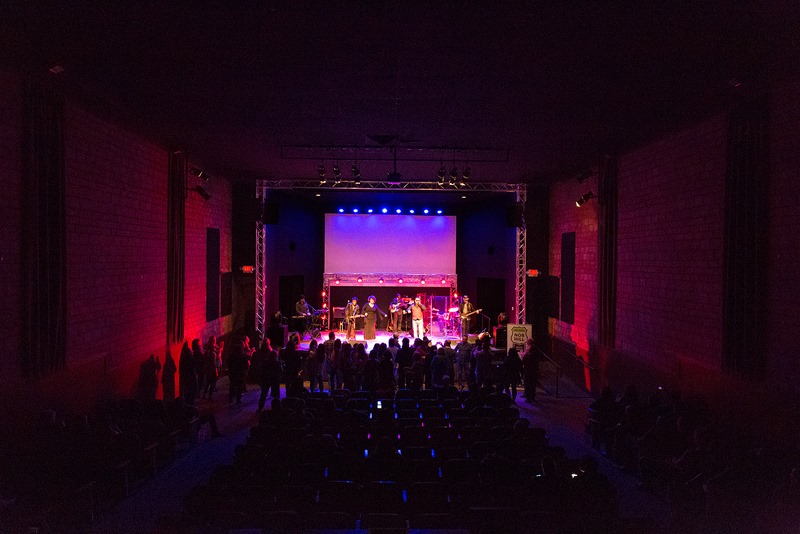
I am stunned!
See the bottom of that screen?
That seems to be a new screen, not the one I saw, but it is about the same size.
When I was at the Lobo in the 1970’s and early 1980’s,
there was a false stage floor raised almost to the height of the bottom of the screen!
I always found that odd and I was convinced that, beneath the false stage floor, there must have been a real one.
I was right!
I am so glad that the new owners took that fake one out.
A Google search revealed another Facebook photo, this one by Nicole Pals, from 2016,
taken from the balcony.
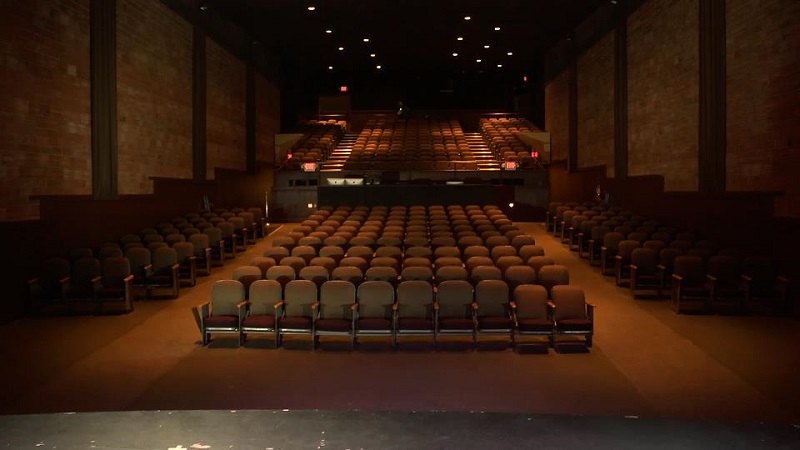
Someone from a group called “Spotlight On” took this shot from the stage.
When I was first in the building in 1974, it was just barely inviting.
When I was back just two or three years later, much of the décor had been removed from the lobby.
When I see these and other recent photos, I am a bit saddened
that what tiny hint of character that the building ever had has since been streamlined away.

Someone from a group called “Spotlight On” took this shot from the stage.
When I was first in the building in 1974, it was just barely inviting.
When I was back just two or three years later, much of the décor had been removed from the lobby.
When I see these and other recent photos, I am a bit saddened
that what tiny hint of character that the building ever had has since been streamlined away.
Why was that fake stage ever installed to begin with?
Not only was the fake stage too high to crawl up onto from the auditorium,
it also had a protruding lip, making it nearly impossible to scale.
Therein, I guess, lies the answer to my query.
I bet some kids walked onto the real stage and did some damage.
The management then built a false stage atop it to prevent such damage from happening ever again.
Is that a good guess?
I don’t know, but what else could have been the reason?
The stage is not deep, as we can see from the outside,
and it is not rectangular either.
It is a trapezoid, with stage left deeper than stage right.
Here’s a satellite’s-eye view from Google Maps:
Now let’s take a look at the Sanborn map:
Now that I’ve got Albuquerque on my mind again,
let’s take a little tour through a few other Albuquerque cinemas.
Text: Copyright © 2019–2021, Ranjit Sandhu.
Images: Various copyrights, but reproduction here should qualify as fair use.
If you own any of these images, please contact me.
Images: Various copyrights, but reproduction here should qualify as fair use.
If you own any of these images, please contact me.
